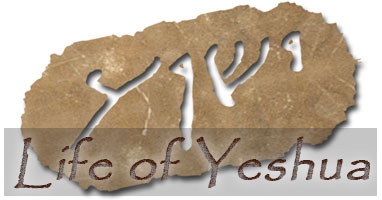How to cite this article:
David N. Bivin and Joshua N. Tilton, “LOY Excursus: Catalog of Markan Stereotypes and Possible Markan Pick-ups” The Life of Yeshua: A Suggested Reconstruction (Jerusalem Perspective, 2015) [https://www.jerusalemperspective.com/13743/].
Updated: 3 October 2024
This excursus, which is a work in progress, is an attempt to identify and collect certain redactional words and phrases characteristic of the editorial style of the author of Mark’s Gospel.
Robert Lindsey believed that the Gospel of Mark is a highly edited epitome of Luke’s Gospel.[1] One of the clues that led Lindsey to reach this conclusion was the recurrence of certain words in Mark that are difficult to translate to Hebrew. These un-Hebraic words and phrases interrupt the otherwise highly Hebraic quality of Mark’s Gospel. These words and phrases also appear with unusually high frequency in the Gospel of Mark, especially in comparison with the other Synoptic Gospels. Lindsey referred to such words as “Markan stereotypes.” The most well known of these stereotypes is εὐθύς (evthūs, “immediately”), which occurs 7xx in Matthew, 41xx in Mark and 1x in Luke. Lindsey further observed that the instances of εὐθύς in Matthew are always in parallel with instances in Mark, whereas the single instance of εὐθύς in Luke is not paralleled in Mark. Thus, the author of Matthew was clearly influenced by Mark’s use of εὐθύς, while Luke demonstrates independence from Mark and at the same time produces a more Hebraic text than what we have in Mark’s Gospel. For Lindsey this was one indication that the author of Mark used the Gospel of Luke as his source.[2] This catalog attempts to identify other examples of this kind.
Another indication that drew Lindsey to this conclusion was his observation that there are certain words and phrases employed by Mark that do not appear in the Lukan parallels but that the author of Luke utilized elsewhere in Luke and/or Acts.[3] Lindsey wondered why Luke would have avoided using these terms in parallel with Mark, if indeed the Gospel of Mark was the basis of Luke’s Gospel, as believed by Markan priorists. Lindsey further noted that these words and phrases are frequently rejected in the Matthean parallels as well. The Lukan-Matthean agreements against Mark to omit these phrases strongly suggested to Lindsey that they are foreign to the pre-synoptic tradition. Lindsey concluded that the best explanation for the strange phenomenon of Mark’s use of Lukan vocabulary in places where Luke’s parallel lacks the Lukan terminology is the author of Mark’s use of Luke-Acts as the primary source for his Gospel.
A good example of the phenomenon described in the above paragraph is the phrase τὸ εὐαγγέλιον (to evangelion, “the gospel”).[4] Lindsey observed that τὸ εὐαγγέλιον never appears in the Gospel of Luke, but it does occur twice in Acts: once in an address by Peter (Acts 15:7), and once in an address by Paul (Acts 20:24). In contrast to the Gospel of Luke, τὸ εὐαγγέλιον occurs in the Gospel of Mark 8xx. What is more, Luke and Matthew agree 4xx against Mark to omit τὸ εὐαγγέλιον,[5] and Matthew and Mark agree to use τὸ εὐαγγέλιον only once (Matt. 26:13 ∥ Mark 14:9). Lindsey reasoned that it is unlikely that the author of Luke would have rejected τὸ εὐαγγέλιον while copying Mark, as must be assumed by those subscribing to the theory of Markan Priority, since Luke was willing to write τὸ εὐαγγέλιον at appropriate points in Acts. It is more likely, according to Lindsey, that the author of Mark chose to insert τὸ εὐαγγέλιον into his text while copying stories from Luke and that the author of Matthew often rejected τὸ εὐαγγέλιον because he did not find it in his parallel source, a source that Luke had utilized when composing his Gospel.[6]
Another example of this phenomenon is Mark’s use of ἐκτινάσσειν (ektinassein, “to shake off”) in Mark 6:11. Matthew followed Mark in the use of ἐκτινάσσειν (Matt. 10:14) in the phrase “shake off the dust,” whereas Luke, in his parallel, used the verb ἀποτινάσσειν (apotinassein, “to shake off”; Luke 9:5). Although the difference in vocabulary may initially seem insignificant, the variation becomes important when we discover that, in Acts, Luke used ἐκτινάσσειν for Paul’s wiping off the dust from his feet (Acts 13:51; cf. Acts 18:6).[7] Why would Luke have avoided ἐκτινάσσειν in Luke 9:5 if this verb had been in his source, especially since this is his preferred vocabulary for situations in which a person wipes the dust from his feet?[8] Lindsey suggested that in such situations Mark intentionally borrowed vocabulary from Acts in the course of rewriting Gospel stories in order to remind his audience how the stories of the later believers in Jesus resonate with Jesus’ own story. In so doing, Mark’s vocabulary sometimes became more Lukan than the Gospel of Luke. Lindsey coined the term “Markan pick-up” to describe the phenomenon of Lukan terminology appearing in the text of Mark. Further examples of this kind can be observed in the catalog below.
Lindsey also identified a clear motivation for the Markan pick-ups: the pick-ups were intended to echo the experiences of Jesus’ later followers in the stories the author of Mark told about Jesus. For instance, in the story of the paralyzed man, Matthew and Luke agree against Mark to use a word other than κράβαττος (krabattos, “pallet”) to refer to the paralyzed man’s bed (κλινίδιον in Luke; κλίνη in Matthew).[9] Lindsey noted that although κράβαττος never appears in Matthew or Luke, it is used twice in Acts (Acts 5:15; 9:33). The story of the paralyzed man in Mark 2 is similar to the story in Acts 9 of Peter’s healing of Aeneas. Likewise, the story in Mark 6 of the healing of many, where the people bring out the sick on pallets (ἐπὶ τοῖς κραβάττοις; Mark 6:55), is similar to the story in Acts 5 where the sick are brought out on cots and pallets (ἐπὶ κλιναρίων καὶ κραβάττων; Acts 5:15) in order to be healed by Peter. Lindsey believed that for the edification of his audience Mark imported the word κράβαττος from Acts into his versions of the Gospel stories about Jesus in order to allude to the similar experiences of Peter.

Having identified the phenomenon of Markan pick-ups from Luke-Acts, Lindsey later concluded that the author of Mark also picked up words and phrases from other sources, most notably from the Epistles of Paul and the Epistle of James.[10] For example, Lindsey noticed that only two places in the entire NT mention anointing the sick with oil: Mark 6:13 and James 5:14. Lindsey suggested that the author of Mark told a story about Jesus’ disciples anointing the sick with oil in order to reflect the practice of later followers as described in the Epistle of James. By means of the Markan pick-ups, the author of Mark was able to show continuity between Jesus’ story and the experiences of Jesus’ later followers, right up to the experiences of the communities for whom his Gospel was composed.[11]
As already mentioned, this catalog is a work in progress and is therefore not exhaustive. We will continue to add to the catalog as further Markan pick-ups and Markan stereotypes are identified in the course of our research for The Life of Yeshua: A Suggested Reconstruction. We also hasten to add that the catalog is not intended to be definitive: the catalog includes possible examples of Markan pick-ups for which there undoubtedly are alternative explanations. The purpose of the catalog is to collect in one place all the examples that might qualify as Markan pick-ups so that the cumulative effect of the phenomenon can be measured.
For a word or phrase to qualify as a possible Markan pick-up, it is not sufficient that the word or phrase in question appears, for example, in both Mark and Acts. It is also necessary to show that the word or phrase appears in contexts that are in some way similar, like the example of κράβαττος discussed above. We realize, of course, that the explanation itself does not constitute proof of Lindsey’s theory, however the more often a possible pick-up can plausibly be explained in this way, the more likely it becomes that Lindsey’s explanation is correct. It is, therefore, important to include examples of possible pick-ups that are not certain, since it is the cumulative effect that must be evaluated.[12] While it may be easy to dismiss any one example as random, or inconclusive, or explicable on other grounds, the cumulative evidence becomes more impressive. Thus, the catalog is not intended to prove that the author of Mark picked up words and phrases from Acts, the Pauline Epistles and the Epistle of James. The catalog’s purpose is rather to collect the raw data that supports Lindsey’s hypothesis so that the cumulative evidence can be considered and scholars can evaluate whether or not Lindsey’s hypothesis is convincing.[13]
To view the catalog click on the link below:
 Click here to return to The Life of Yeshua: A Suggested Reconstruction main page.
_______________________________________________________
Click here to return to The Life of Yeshua: A Suggested Reconstruction main page.
_______________________________________________________
- [1] See “LOY Excursus: Mark’s Editorial Style.” For abbreviations and bibliographical references, see the Introduction to The Life of Yeshua: A Suggested Reconstruction. ↩
- [2] See Robert L. Lindsey, “Introduction to A Hebrew Translation of the Gospel of Mark,” under the subheading “The Markan Stereotypes.” ↩
- [3] Abbott (Corrections, 113 n. 7) remarked that there are several Markan words that are “rejected by Lk. in the Gospel but retained by him in…Acts.” Foakes Jackson and Lake likewise noted that there are “several cases where a motif in the gospel of Mark is omitted by the parallel in the gospel of Luke only to reappear in Acts” (Foakes Jackson-Lake, 4:134). The cases Foakes Jackson and Lake cited include:
- Acts 1:7 and Mark 13:32 (unparalleled in Luke); cf. Foakes Jackson-Lake 4:8.
- Acts 5:15-16 and Mark 6:55-56 (unparalleled in Luke); cf. Foakes Jackson-Lake 4:54-55.
- Acts 6:11-14 and Mark 14:56-64 (unparalleled in Luke); cf. Foakes Jackson-Lake 4:69.
- Acts 9:40 and Mark 5:40 (cf. Luke 8:53); cf. Foakes Jackson-Lake 4:111.
- Acts 12:4 and Mark 14:2 (cf. Luke 22:2); Foakes Jackson-Lake 4:134.
- Acts 28:8 and Mark 1:31 (cf. Luke 4:39); cf. Foakes Jackson-Lake 4:343.
Foakes Jackson and Lake considered this phenomenon to be the product of Luke’s dependence on the Gospel of Mark. Lindsey accounted for the same phenomenon by suggesting that the literary dependence flowed in the opposite direction: Mark embellished his gospel narratives with details from Luke-Acts. At the very least, this phenomenon is evidence that there is a direct literary relationship between Mark and Luke-Acts. ↩
- [4] See Robert L. Lindsey, “Introduction to A Hebrew Translation of the Gospel of Mark,” under the subheading “The Markan Stereotypes.” ↩
- [5] Luke and Matthew agree against Mark to omit τὸ εὐαγγέλιον at Matt. 4:17 and Luke 4:14 opposite Mark 1:14; Matt. 16:25 and Luke 9:24 opposite Mark 8:35; Matt. 19:29 and Luke 18:29 opposite Mark 10:29; Matt. 10:18 and Luke 21:13 opposite Mark 13:10. ↩
- [6] For an overview of Lindsey’s solution to the Synoptic Problem, see the Introduction to The Life of Yeshua: A Suggested Reconstruction. ↩
- [7] For further evidence of editorial activity in Mark 6:11, note the Lukan-Matthean agreement to write τὸν κονιορτόν (ton koniorton, “the dust”; Luke 9:5 ∥ Matt. 10:14) against Mark’s τὸν χοῦν (ton choun, “the dust”), as well as their agreement against Mark to omit τὸν ὑποκάτω (ton hūpokatō, “[that is] under”). ↩
- [8] See Cadbury’s comments on Acts 13:51 in Henry J. Cadbury, “Note XXIV: Dust and Garments” (Foakes Jackson-Lake, 5:269 n. 4). ↩
- [9] See Robert L. Lindsey, “Introduction to A Hebrew Translation of the Gospel of Mark,” under the subheading “Sources of the Markan Pick-ups”; idem, “My Search for the Synoptic Problem’s Solution (1959-1969),” under the subheading “Markan Pick-ups.” ↩
- [10] See Robert L. Lindsey, “Measuring the Disparity Between Matthew, Mark and Luke,” under the subheading “Further Proof of Mark’s Dependence on Luke”; idem, “From Luke to Mark to Matthew: A Discussion of the Sources of Markan ‘Pick-ups’ and the Use of a Basic Non-canonical Source by All the Synoptists.” ↩
- [11] On the pastoral function of the Markan pick-ups, see Joshua N. Tilton, “Reflections on Mark.” ↩
- [12] Climate scientists run into a similar problem when they are asked whether a particular storm is due to global climate change. While it is extremely difficult to definitely attribute any individual storm to global climate change, the cumulative evidence does show a pattern that there are more frequent and more powerful storms. If the scientists dismissed as evidence every storm that could not conclusively be proven to be the result of global climate change, they would never be able to see the overall pattern. Likewise, the cumulative examples of possible Markan pick-ups may indicate an overall pattern, but the overall pattern cannot be identified without documenting all of the possible pick-ups. ↩
- [13] Special thanks are due to Lauren Asperschlager who diligently checked all the Scripture references in the catalog. ↩

































































































